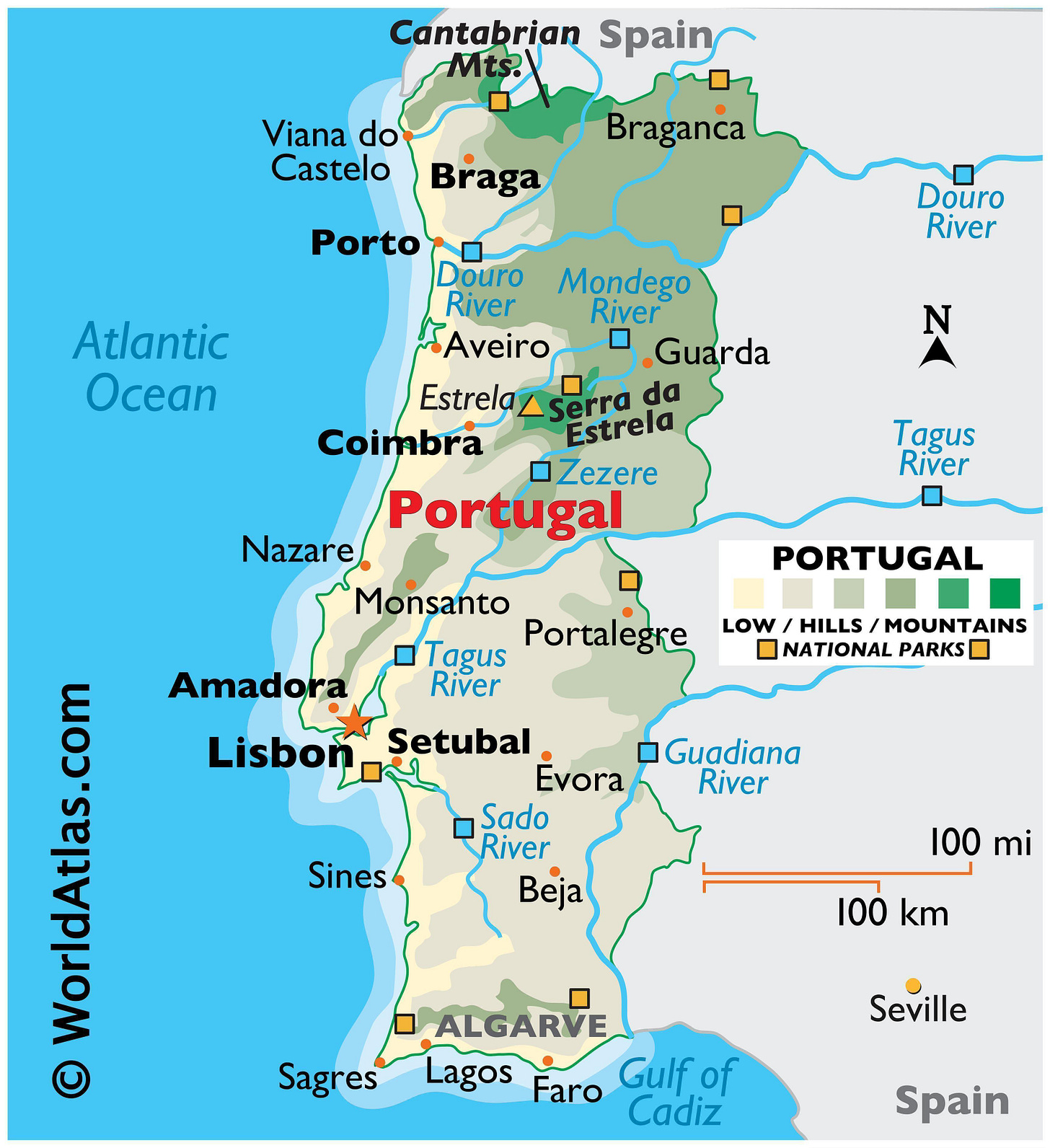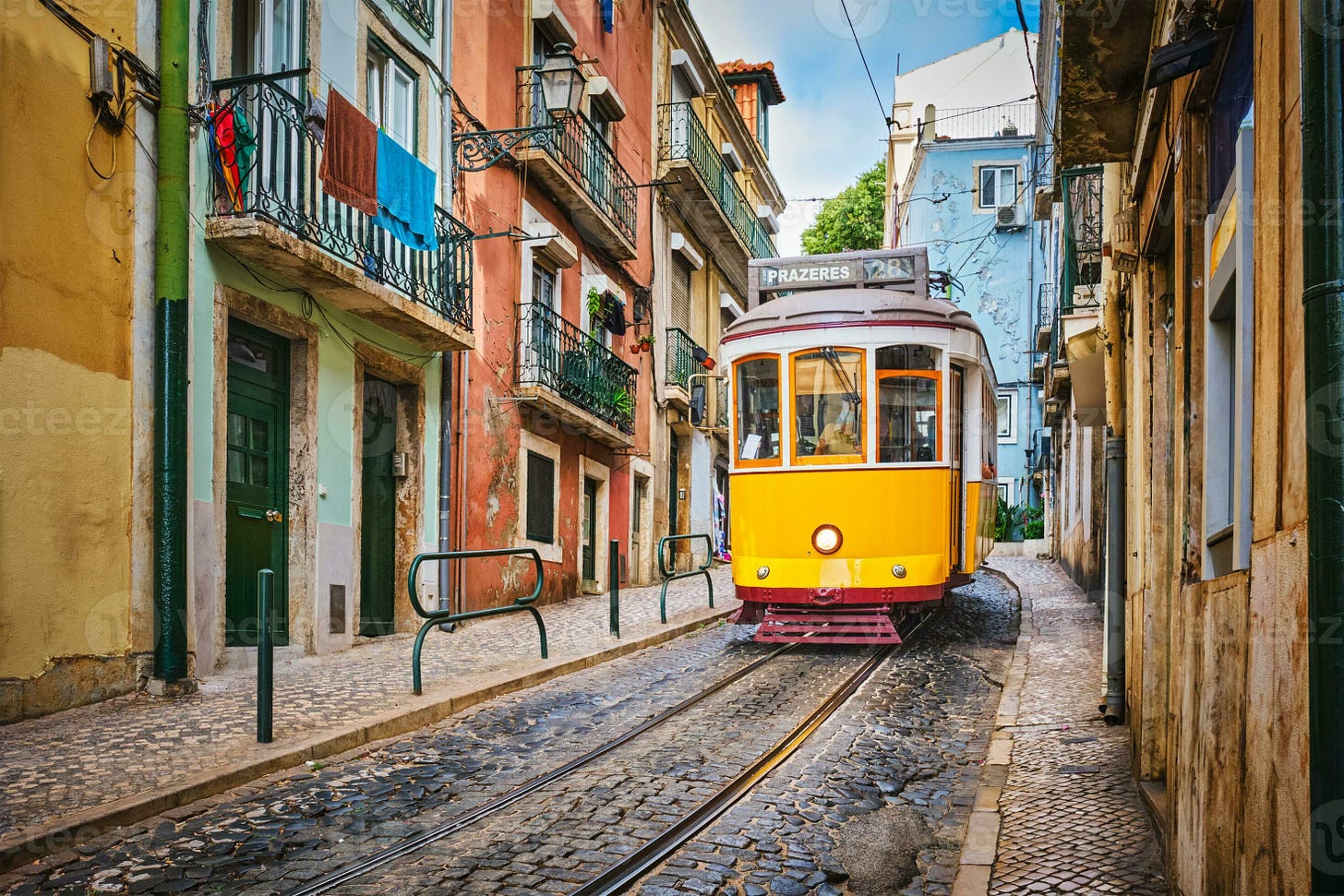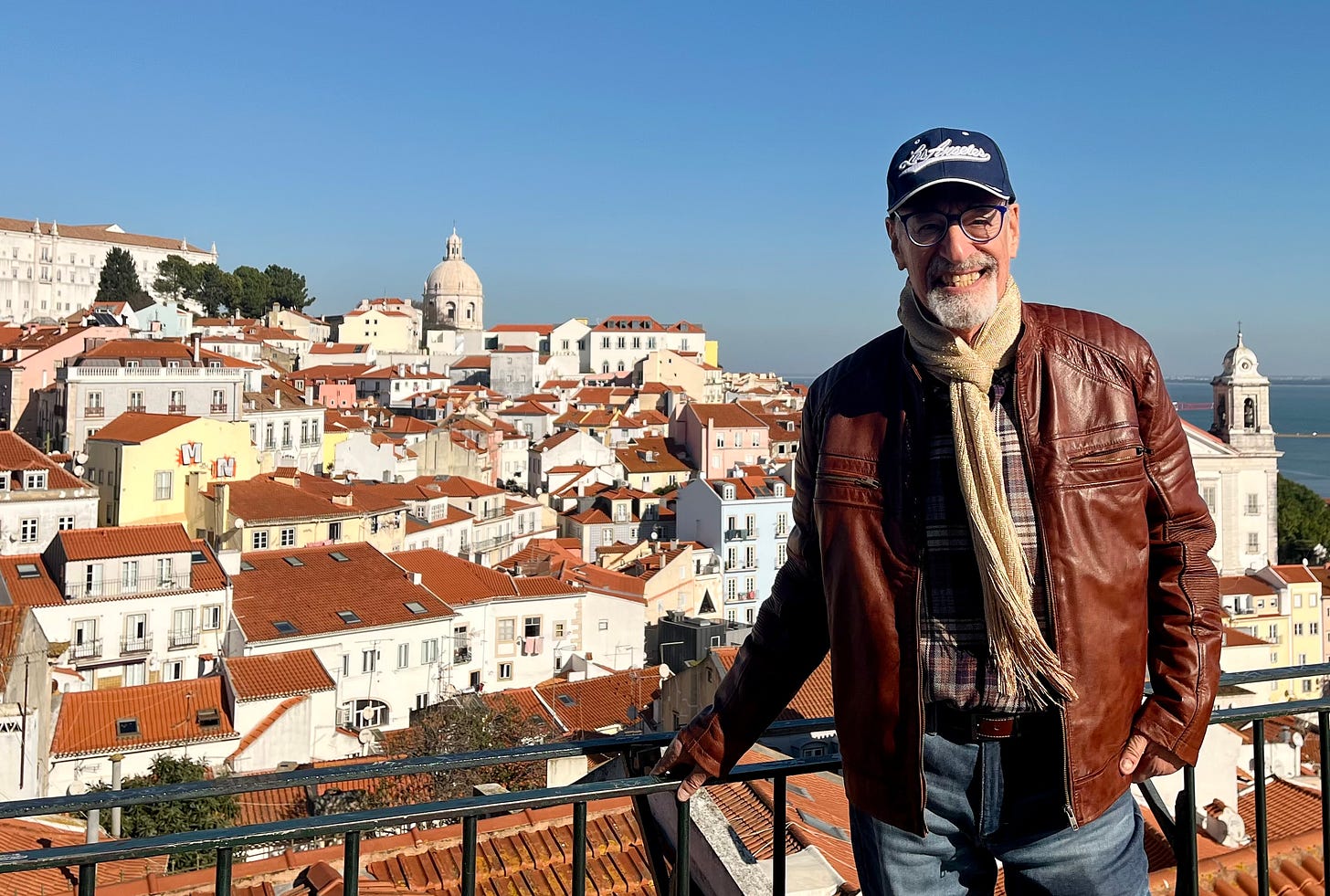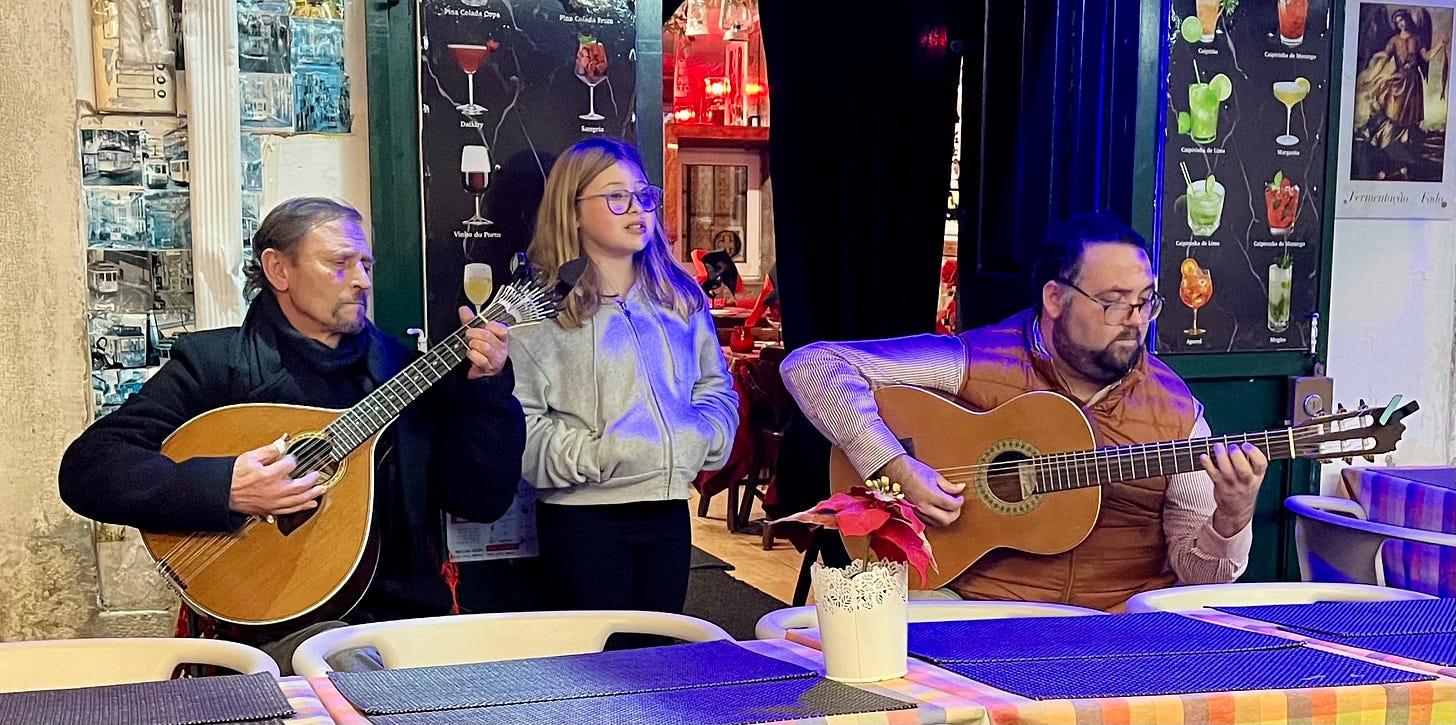Today is Valentine’s Day AND my 22nd anniversary!
So perhaps, if you’re enjoying the music here – as much as I did in there, in Lisboa…
…take a listen to this while reading:
The most westerly country in Europe (surprisingly more west than both Great Britain and Ireland), Portugal is about 349 miles long and 135 miles wide. For you Americans, it’s roughly the size of Indiana or Maine. A comfortable size to navigate in two weeks.

First, a little history.
Humans have lived in the area that’s now Portugal since at least 400,000 years ago. The earliest human remains found there are Neanderthal-type bones. A distinct culture emerged during the Mesolithic period (10,000 – 8000 BCE).
Due to its excellent trading location, the Phoenicians settled in what is now Lisbon around 1200 BC. The Romans invaded the Iberian Peninsula in 219 BC, and the region became the Roman province of Lusitania in 27 BC. The city of Olissipo (modern-day Lisbon) was an important Roman settlement, although it may be 400 years older than Rome itself.
In the medieval period, the region was occupied by Germanic tribes (Visigoths) after the decline of the Roman Empire. Then, after the death of Mohammad, the Umayyad Caliphate forcibly conquered the Iberian Peninsula, making it part of “al-Andalus”. After Portugal’s first king, Alfonso 1, repelled the Moors in 1139 (over 300+ years before Ferdinand and Isabella defeated the Moors at Granada in 1492), the Portuguese kings expanded their territory in the 12th and 13th centuries
During the “Age of Discovery”, Portuguese explorers, with the advantage of their superior sea technology, established a vast colonial empire in the 15th and 16th centuries (from Goa, India to Brazil, South America). The most famous Portuguese navigators from that time include Vasco da Gama (the first European to reach India) and Prince Henry the Navigator (the funder of the Portuguese adventurers who sailed from Belem, a harbor just north of Lisbon), with others like Bartolomeu Dias (who rounded the southern tip of Africa in 1488) and Duarte Pacheco (who explored the South Atlantic and the South American coast).

Portugal fell from being a world power by the end of the 16th century, usually playing second fiddle to Spain, until in the modern period, she became a member of the European Union in 1986, handing over its last overseas territory, Macau, to China in 1999 (after previously losing Brazil, Angola, and Timor). Portugal is a member of NATO and has maintained positive relations with the United States since 1791.
I think it’s the most beautiful part of the City because it reeks of character, history, and charm.

Every cobblestone street has modern-day bistros mixed with old-world residential buildings, both seemingly restored and refurbished to the original architectural style, with upgrades made for tourists and expats, particularly of the American persuasion. You can’t walk down a single one in the Alfama without seeing five tapas restaurants, four wine bars, three artsy store windows full of perfectly seductive and beautiful Portuguese trinkets, two travel/tour guide shops, one Gothic church, and a partridge in a pear tree.
Walking the streets of Alfama is like stepping back in time to a medieval Portuguese labyrinth. The near-vertical hills can be a struggle to climb (less so in winter), but just perch yourself atop one of the high “miradouros” (viewpoints), perhaps “sipping a cold one” at an outdoor beer or wine cafe, and you will be breathtakingly rewarded with an entire view of the city, its stone palaces, endless mazes of winding streets, all with flower-clad iron railings… and with the mighty Tagus River itself, flowing into the Atlantic.

Not to say that the rest of beautiful Lisboa isn’t as traveler/tourist friendly; it’s just newer, since it has been rebuilt after the devastating 1755 earthquake. But c’mon, 1755? That 21 years before the American Revolution. With names like Bairro Alto (roughly “downtown”), Castelo, Graca, Anjos (cool for expats and nightlife), Alcantara, Estrela, and Chiado, a key shopping hub (none of whose names can I pronounce close to correctly in Portuguese), the City is a mecca for visitors of all persuasions.
We went on a two-hour walking tour on our first morning (always a good idea), from Praca do Comercio (Commerce Square), a grand waterfront plaza, making our way through the winding geography and history of Portugal, both good and bad, with a perfectly fluent guide from Iceland, Telma, who hadn’t cut her golden reggae locks in ten years. She was the first of several tour guides we met, most of whom were foreigners themselves, each of whom told the story of Portugal in their own unique way, warning us how not to fall into the most popular tourist traps, and how best to stretchhhhh… our Euros.

Then… there’s the music. Fado music! Definitely one the best things about staying in the Alfama, where behind every miniature Lisboa door, lies a local “fado house”, from where the sound of the most beautiful and heartbreaking music you’ve ever heard, comes washing over you each and every night of your stay.
If you haven’t yet listened to the YouTube video at the top of this post, now is the time. Or here’s another with the soulful Alfredo Marcineiro singing:
How to describe fado music? Let me try.
Impossible. After all, it’s music. Different from words altogether. Another art form unto itself.
But any trip to Lisboa would be incomplete without a good dose of fado. In fact, without a full immersion.
So… let me try again:
Fado originated in Portugal around the 1820s, but it’s thought to have much earlier origins, most probably deriving from Africa and Brazil. It’s traditionally sung by a soloist, either male, or more frequently female, and accompanied by a Portuguese guitarra, a pear-shaped cittern with twelve wire strings, sometimes backed by a classical guitar, a braguinha, and even sometimes, a full orchestra on stage. It is, however, more frequently associated with pubs, cafés, and restaurants, especially with sailors and prostitutes.
That’s the easy part.
Because it’s really the heart-breaking sound, beauty, and melancholy of fado that makes it so soulfully unique to Portugal, where the soloist, often with eyes closed to connect to their inner “saudade” (longing), will sing about their life’s hardships and suffering, instinctively intertwining pain, resignation, love, loss, and hopefulness into a gorgeous musical tapestry.
I especially love the “mournfulness” of fado. Combined with its musical beauty, it touches a deep part of myself that I think only Irish traditional ballads do, in a similar, but also in a special way of their own. And who doesn’t love a sad, heart-breaking Irish song about loss? Right, Mr. Van Morrison?
So… although I booked a fado night in a touristy Lisbon club before we even left for Portugal, it was one of the best surprises of our entire trip that – right at the top of the small alleyway (“that had the balls to call itself a street”), directly above the studio we rented in the Old Jewish Quater, that there… every night… was a live fado show… featuring a two finger virtuoso Portuguese guitarra player, a heavy set classical guitar accompaniest, and with different singers every night. Often I, sipping my favorite local Portuguese beer, would be an audience of one, soaking up the “saudade”. I truly hope the fadistas enjoyed my deep appreciation.
Here’s a photo of a 10-year-old girl singing fado with the mature voice of a broken-hearted prostitute:

I could go on…. but take a listen for yourself.
And… I could on… about all the other Lisboan things we did in Lisbon,
but
I promised my sister that I would keep these short.
So… more anon…
Ahhhhh, I wish I was stillllll there!
xo
Trules
If you enjoyed this post, or any previous ones, please LEAVE A COMMENT. It helps build an enthusiastic and interactive readership…. which I greatly appreciate!
If you have any friends who you think might enjoy Santa Fe Substack, PLEASE SHARE IT WITH THEM.
ALSO, IF YOU FIND A TYPO (a casualty of being your own editor!), please let me know so I can fix it.
And another REMINDER: please CHECK OUT “TRULES RULES on SUBSTACK” with over 100 posts and re-posts of “rants, raves, reports, and embarrassments, plus points of view & top-rated travel podcasts – along with some common sense”.
Thanks so much!
With a little Bonus Fado!
To read more of Trules’ travel tales, GO TO my “e-travels with e. trules” blog
Or to listen to my travel PODCAST, GO HERE

Visit my personal blog “Trules Rules” HERE
Or go to my HOMEPAGE
My Twitter (X) : Fxxk Twitter